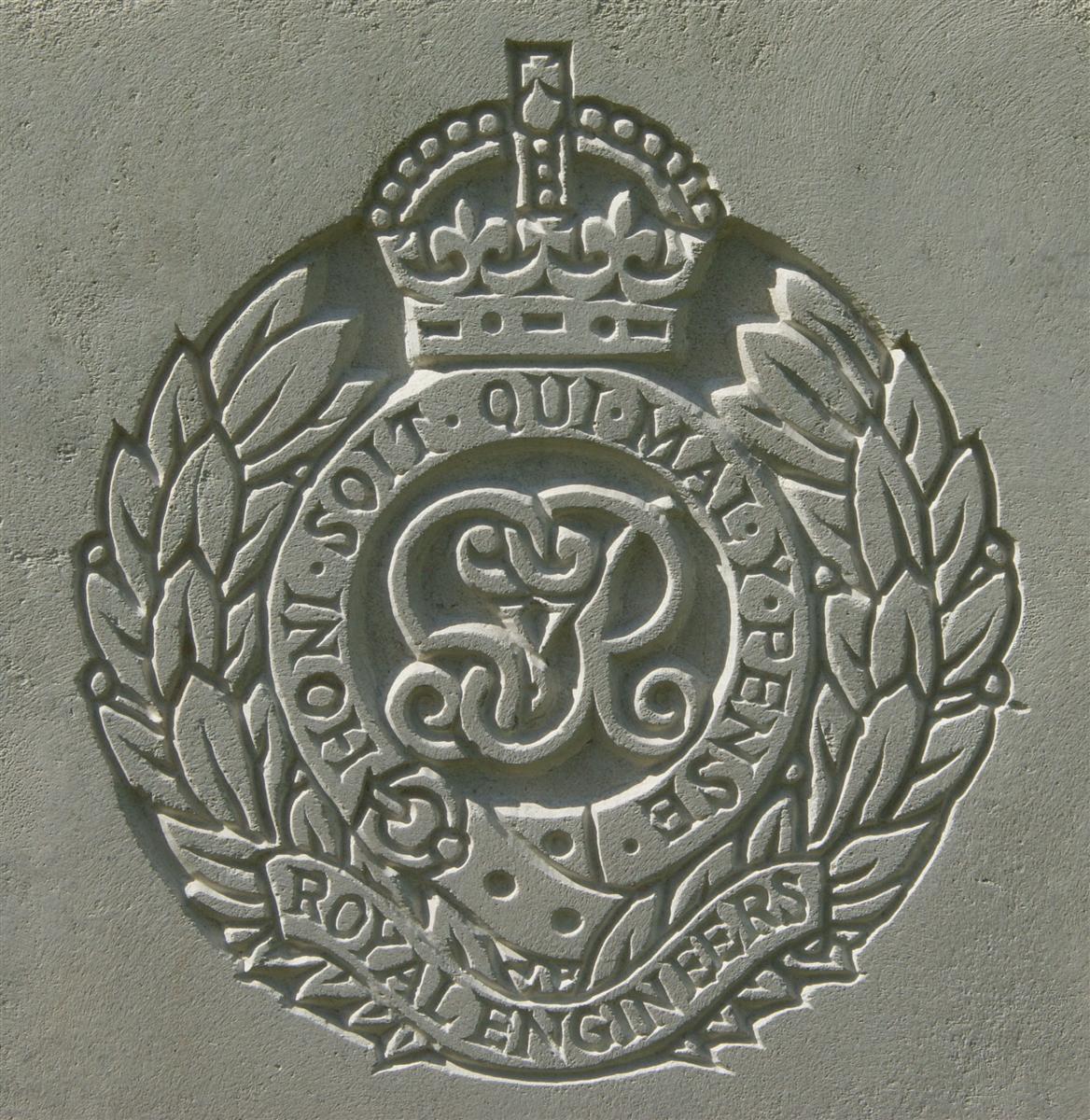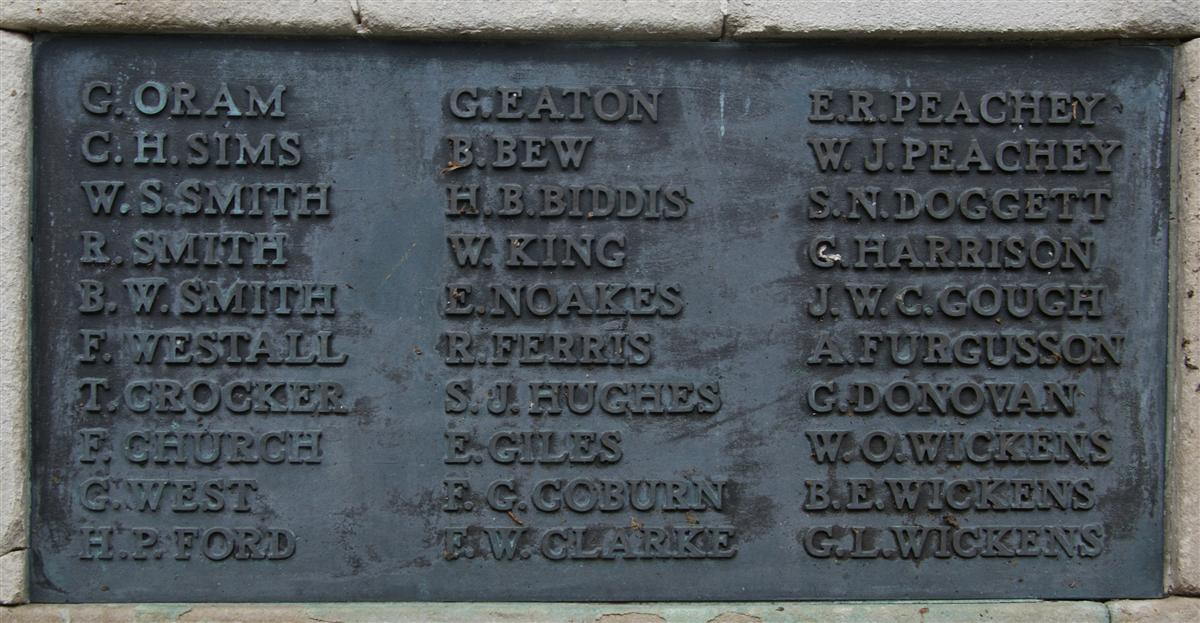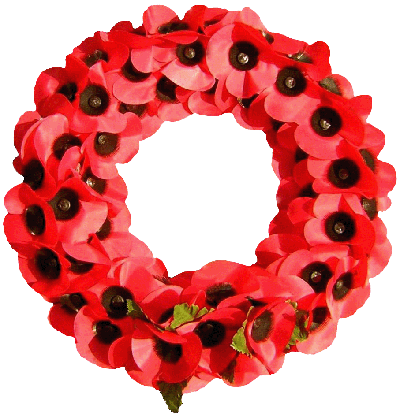Willam Sidney Smith
Sapper 498433 William Sidney Smith, 227th Field Company, Royal Engineers
The Newbury war memorial in Bartholomew Street holds the names of 339 WW1 casualties, but this does not reflect all the losses of young men from the town. In the case of the name W S Smith there were two local casualties of that name: Walter Sidney Smith from Speenhamland went down with HMS Good Hope in November 1914 and William Sidney Smith from West Fields died during the German Spring Offensive in 1918 . There is good reason to believe that it is William's name that is on the memorial.
The names on the memorial are, in general, distributed randomly around the 13 bronze tablets mounted on the wall around the memorial cross, 12 of which hold the names. Exceptions to this random order include the cases of brothers, who are very often grouped together. W S Smith appears immediately above R Smith and B W Smith - William's brothers Richard and Benjamin Weller Smith. This grouping is one argument that William is the W S on the memorial, but, perhaps, a more powerful argument is that it is almost impossible to think of their parents putting forward only two of their sons for commemoration.
So it is William’s story that his told here. Walter was generally known as Sidney, he is believed to be the S Smith rembered on tablet 1 of the memorial, for his story click here.

'Church View Villas' today - minus No 4. |
The family consisted of Sidney, Kate and their four children : Edith Rachel (born 1884), William Sidney (1887), Richard (1890) and Benjamin Weller (1892).
After his schooling, which was probably in the local National School, William followed his father’s trade becoming a carpenter and joiner. His brother Richard, also a joiner, worked for Elliott’s, a large joinery business in Albert Road, Newbury; it is possible that Sidney and William also worked for the same company, which was a major employer in Newbury at that time.
Soon after war was declared companies like Elliott’s received large orders from the War Office, in their case they were producing thousands of ammunition boxes – and needed every available man. While it is not known for certain that William worked at Elliott’s it is easy to see how he might have become involved in the war effort at home and perhaps felt he was ‘doing his bit’

Royal Engineers at work. |
On 23 March 1918 the Germans launched a huge offensive along the Somme, smashing through the British defences under the cover of fog they were soon crossing the Crozet Canal and the Somme. The 39th Division, as part of XIX Corps was caught up in this maelstrom; by the 28 March their position was untenable, no more than a line on a map. The French to their south were falling back, the Germans were behind them to the north; they had no choice but to fall back again. The 39th Division (by this time much depleted) was selected to be the rearguard. Any man who could hold a rifle was expected to fight, though the Engineers may well have been busy preparing to demolish bridges, railways or anything else that might be of use to the enemy – the very structures that they had been busy building since the area was occupied during the fighting in 1916 and the subsequent German withdrawal to the Hindenburg line.

The regimental badge of the Royal Engineers, as used on CWGC headstones. |
When Sidney and Kate got news from the War Office that their last son was missing their natural hope - that he was a PoW - was more likely to have been fulfilled than the hopes of parents hearing the same news after previous battles:
Newbury Weekly News, 23 May 1918 - Missing
SMITH – Mr and Mrs Smith, of 4, Church-view, West Fields, Newbury, have been informed that their son, Sapper W S Smith, 498,433, 227th Field Company, RE, 3rd Section, has been missing since the 28th of March. Any information regarding him will be gratefully received by his parents and family.
However, the news that followed was that William had died in those desperate days, when the Allies came far too close to losing the war.

William's name on Newbury War Memorial, above those of his brothers. (left) |
Sidney had Kate had lost their last son; William’s body was never identified, his name is remembered on the Pozieres Memorial.
Locally he is remembered on Tablet 11 of the Newbury Town War Memorial and the parish memorial board and roll of honour in St Nicolas Church, Newbury.
William’s brothers had died the previous year, Richard in action with the 106th Company, Royal Engineers and Benjamin struck by lightning while working with a Labour Corps detail.

